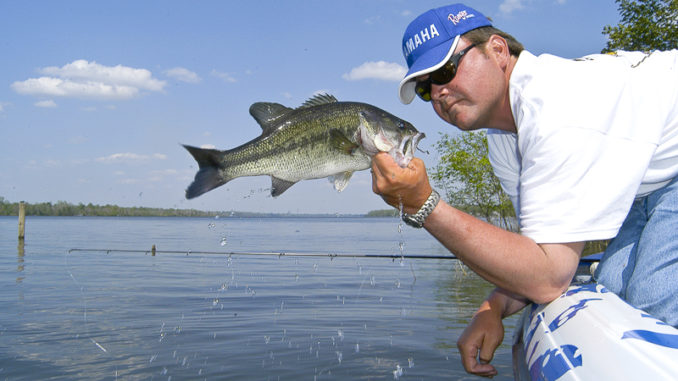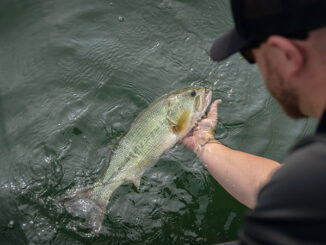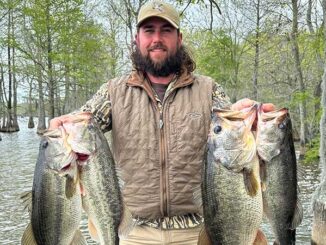
Bass are biting in plenty of places, on plenty of baits
Who doesn’t love bass-fishing in May? I don’t know anyone, because May is such a great month to fish in the Carolinas. It’s a month when you can catch ’em just about anyway you want to. You have some late-spawning fish, and you have fish that have already finished spawning and are feeding again. The end of May/first of June is one of my favorite times to fish.
The first thing to understand is that bass in different parts of a big lake will be in different stages. Maybe in the upper end of a lake, where they spawn first, they’ve finished spawning and have already moved out, are ganged up and starting to feed. That’s very different from down the lake, where they spawn a couple of weeks later. The first fish you catch after the spawn are bucks. The female fish get a little sickly for a while before they get hungry again. The fish hang out shallow for a little while, chasing bait, until they get hungry about two weeks after the spawn.
When they start feeding again, that’s when topwater fishing can be real good. And anglers using a jerkbait can be very effective. You’re looking for fish in 7 to 10 feet of water that are still feeding over their heads, looking up.
Where and when
What you need to figure out is what the fish are doing in different places on the lakes you’re fishing. And then, figure out where you need to go to catch the really good ones. This is really the only month you get to make that choice. If you like to sight-fish for bedding fish, you’ll go to the lower end of the lake and the backs of those creeks, places they spawn the latest. If you want fish that have recovered from the spawn and moved out, you’re going to go to the upper end of the lake and figure out a pattern up there.
In some of our more southern lakes, fish may spawn in April and already be out on structure in May. In some of the lakes along the Virginia line — Buggs Island and Gaston — you have them spawning as late as the end of May and the first of June. And by the end of June they really get good. I’ve always said that July 4 is the best time of the year to catch ‘em at Buggs Island.
Topwater lures, senkos, and swimbaits are all good
The topwater bite can be walking-type baits like a Zara Spook, some old-time baits like Boy Howdy and Devil’s Horse. The Senko-type bait that Berkley makes, the General, that can be real good. Nowadays, swimbaits are really good.
What I want to do is find the fish that are a little more aggressive. And that’s usually the ones that have recovered from the spawn and moved out. What makes it exceptional is that the fish are starting to get ganged up. You were catching one here and one there. And now, all of the sudden, you’re catching five or six on one spot. I don’t want to rely on the topwater bite, unless I’m on a lake with blueback herring.
May is a mid-range month, with fish anywhere from 0 to 10 feet deep. They’ll start moving out to 7 to 10 feet, and by the first of June, they might be around 15 feet. They’ll all be finished with the spawn and feeding, hitting topwaters, plastics or crankbaits. This is a perfect time for a shallow- or medium-running crankbait like my Berkley Frittsides.
Bass on the move
Another thing to understand is that the fish can move and move fast. You have to have an open mind. I’ve been in tournaments when I started catching fish one way, and by the end of the tournament, I ended up doing something else. I fished one on Kentucky Lake one time when I caught them 10 feet deep the first day. But you could tell they were moving deeper, and by the third day, they were on deep structure. I just went and fished and caught ‘em that way.
Normally, I’m looking for fish that are out on flats. They haven’t gotten on the deeper breaks yet, and they’re holding on some kind of structure. One of my favorite ways to fish in May is to locate some stumps in about 8 feet of water on a flat; those are the kinds of places where bass will stage on their way out.
Herring lakes are different
Now, one factor can change everything, and that’s blueback herring. All of the Savannah River lakes in South Carolina have them, and some of our lakes in North Carolina have them. They spawn a couple of weeks after the bass spawn, usually on long, flat points. Blow-throughs, islands with a little shallow spot on one side, roadbeds — they’re all places where bluebacks will spawn. Bluebacks will really turn on the topwater bite on a lake when fish are ready to do something else on a lake that just has shad for baitfish.
You have to fish topwaters, jerkbaits, stuff like that, and you have to fish them shallow, because the bass will be looking up — that’s where the food is. You don’t throw baits that are digging the bottom when you have a herring spawn, because the bass will be concentrating on them. Once the blueback spawn is over, the bass will back off onto those places where you expect them to go after the recover from the spawn.





Be the first to comment